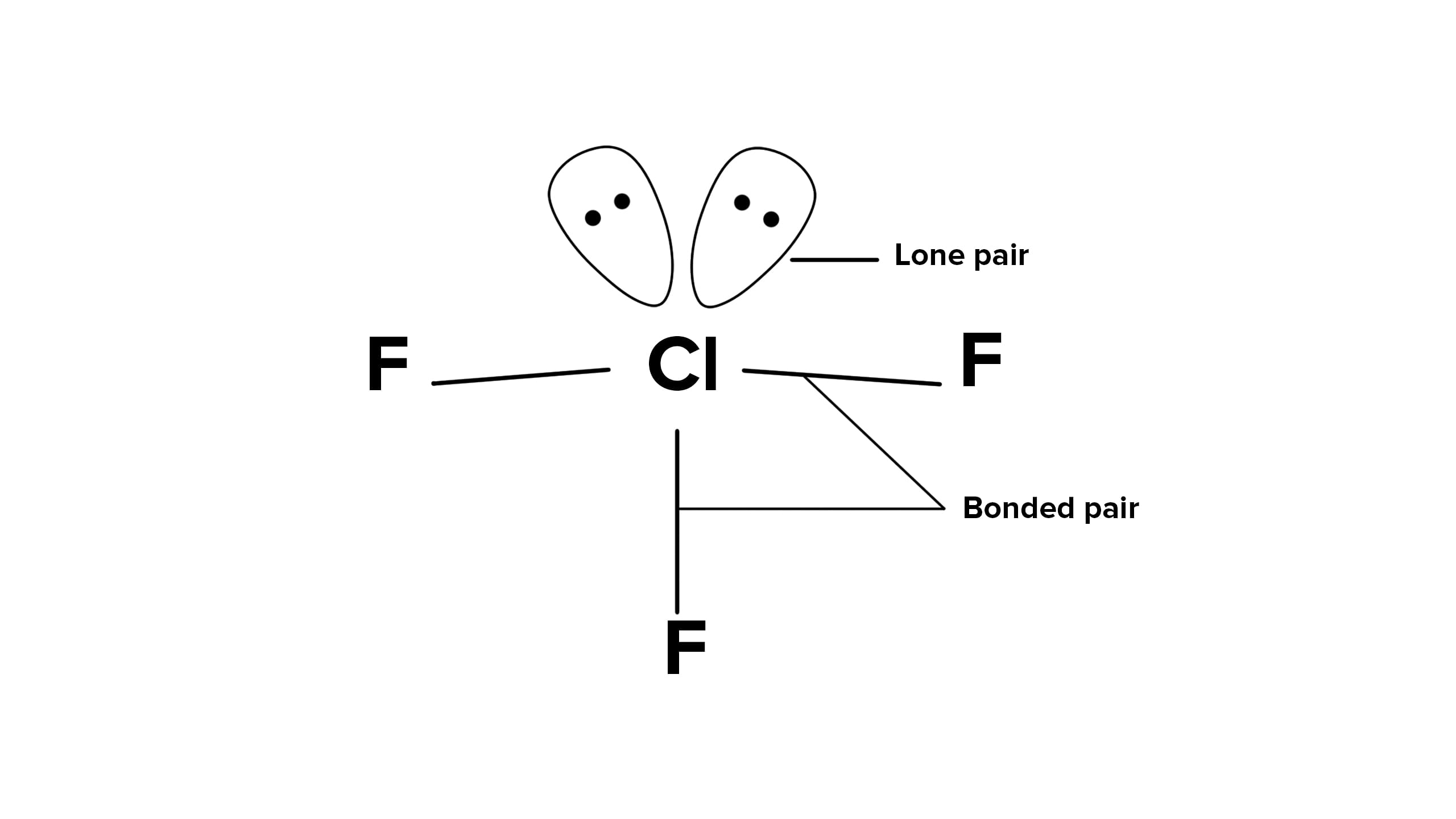In the structure of \({ClF_3}\), the number of lone pairs of electrons on the central atom \(Cl\) is:
- three
- one
- four
- two
The Correct Option is D
Approach Solution - 1
The correct answer is Option D) two
The structure of \(ClF _{3}\) is 
In the structure of ClF3, the number of lone pairs of electrons on the central atom Cl is two. Cl has 7 valence electrons out of which 3 are involved in bond formation with 3 F atoms. 7−3=4 valence electrons remain in the form of 2 lone pairs of electrons.
Approach Solution -2
The correct answer is Option D) two
Some real-life examples of p-block elements:
1. Carbon: It is the building block of all organic compounds. Carbon is also used in many other applications, such as making plastics, steel, and semiconductors.
2. Silicon: It is used to make semiconductors and also used in making solar cells and other renewable energy technologies.
3. Phosphorus: It is also used in making matches, fertilizers, and fireworks.
4. Germanium: It is used in making transistors and other electronic devices, and also used in making infrared detectors and other optical devices.
Question can also be asked as
1. How many lone pairs of electrons does the chlorine atom in ClF3 have?
2. What is the number of unshared pairs of electrons on the chlorine atom in ClF3?
3. How many bonding pairs of electrons does the chlorine atom in ClF3 have?
Learn with videos:
Top Questions on Chemical bonding and molecular structure
What is the empirical formula of a compound containing 40% sulfur and 60% oxygen by mass?
- MHT CET - 2025
- Chemistry
- Chemical bonding and molecular structure
Match the LIST-I with LIST-II.

Choose the correct answer from the options given below :- JEE Main - 2025
- Chemistry
- Chemical bonding and molecular structure
Which of the following molecules(s) show/s paramagnetic behavior?
$\mathrm{O}_{2}$
$\mathrm{N}_{2}$
$\mathrm{F}_{2}$
$\mathrm{S}_{2}$- JEE Main - 2025
- Chemistry
- Chemical bonding and molecular structure
- A group 15 element forms \( d\pi - d\pi \) bond with transition metals. It also forms a hydride, which is the strongest base among the hydrides of other group members that form \( d\pi - d\pi \) bonds. The atomic number of the element is ________________________.
- JEE Main - 2025
- Chemistry
- Chemical bonding and molecular structure
Given below are two statements:
Statement I : The N-N single bond is weaker and longer than that of P-P single bond
Statement II : Compounds of group 15 elements in +3 oxidation states readily undergo disproportionation reactions.
In the light of above statements, choose the correct answer from the options given below- JEE Main - 2025
- Chemistry
- Chemical bonding and molecular structure
Questions Asked in NEET exam
- With the help of the given pedigree, find out the probability for the birth of a child having no disease and being a carrier (has the disease mutation in one allele of the gene) in the F3 generation.

- NEET (UG) - 2025
- Genetics
- The plates of a parallel plate capacitor are separated by d. Two slabs of different dielectric constant \(K_1\) and \(K_2\) with thickness \(d/2\) and \(d/2\) respectively are inserted in the capacitor. Due to this, the capacitance becomes two times larger than when there is nothing between the plates. If \(K_1 = 1.25 K_2\), the value of \(K_2\) is :
- NEET (UG) - 2025
- Capacitors and Capacitance
- The correct order of the wavelength of light absorbed by the following complexes is:
A. $[ \text{Co(NH}_3\text{)}_6]^{3+}$
B. $[ \text{Co(CN)}_6]^{3-}$
C. $[ \text{Cu(H}_2\text{O)}_4]^{2+}$
D. $[ \text{Ti(H}_2\text{O)}_6]^{3+}$
Choose the correct answer from the options given below:- NEET (UG) - 2025
- Coordination chemistry
- Consider the diameter of a spherical object being measured with the help of a Vernier Callipers. Suppose its 10 Vernier Scale Divisions (V.S.D.) are equal to its 9 Main Scale Divisions (M.S.D.). The least count in the M.S. is 0.1 cm and the zero of V.S. is at -0.1 cm when the jaws of Vernier callipers are closed. If the main scale reading for the diameter is \(M = 5\) cm and the number of coinciding vernier division is 8, the measured diameter after zero error correction, is:
- NEET (UG) - 2025
- Measurement of length
- In some appropriate units, time (t) and position (x) relation of a moving particle is given by \(t = \alpha x^2 + \beta x\). The acceleration of the particle is :
- NEET (UG) - 2025
- Kinematic equations for uniformly accelerated motion
Concepts Used:
Chemical Bonding and Molecular Structure
Such a group of atoms is called a molecule. Obviously, there must be some force that holds these constituent atoms together in the molecules. The attractive force which holds various constituents (atoms, ions, etc.) together in different chemical species is called a chemical bond.
Types of Chemical Bonds:
There are 4 types of chemical bonds which are formed by atoms or molecules to yield compounds.
- Ionic Bonds - Ionic bonding is a type of chemical bonding which involves a transfer of electrons from one atom or molecule to another.
- Covalent Bonds - Compounds that contain carbon commonly exhibit this type of chemical bonding.
- Hydrogen Bonds - It is a type of polar covalent bonding between oxygen and hydrogen wherein the hydrogen develops a partial positive charge
- Polar Bonds - In Polar Covalent chemical bonding, electrons are shared unequally since the more electronegative atom pulls the electron pair closer to itself and away from the less electronegative atom.
Factors Affecting Bond Enthalpy in Chemical Bonding:
- Size of the Atom
- Multiplicity of Bonds
- Number of Lone Pair of Electrons Present
- Bond Angle
